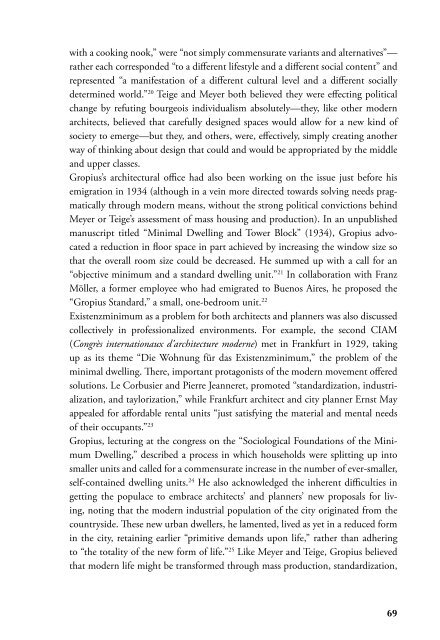The Death and Life of the Total Work of Art – Henry van de Velde and the Legacy of a Modern Concept
ISBN 978-3-86859-261-0
ISBN 978-3-86859-261-0
Create successful ePaper yourself
Turn your PDF publications into a flip-book with our unique Google optimized e-Paper software.
with a cooking nook,” were “not simply commensurate variants <strong>and</strong> alternatives”—<br />
ra<strong>the</strong>r each correspon<strong>de</strong>d “to a different lifestyle <strong>and</strong> a different social content” <strong>and</strong><br />
represented “a manifestation <strong>of</strong> a different cultural level <strong>and</strong> a different socially<br />
<strong>de</strong>termined world.” 20 Teige <strong>and</strong> Meyer both believed <strong>the</strong>y were effecting political<br />
change by refuting bourgeois individualism absolutely—<strong>the</strong>y, like o<strong>the</strong>r mo<strong>de</strong>rn<br />
architects, believed that carefully <strong>de</strong>signed spaces would allow for a new kind <strong>of</strong><br />
society to emerge—but <strong>the</strong>y, <strong>and</strong> o<strong>the</strong>rs, were, effectively, simply creating ano<strong>the</strong>r<br />
way <strong>of</strong> thinking about <strong>de</strong>sign that could <strong>and</strong> would be appropriated by <strong>the</strong> middle<br />
<strong>and</strong> upper classes.<br />
Gropius’s architectural <strong>of</strong>fice had also been working on <strong>the</strong> issue just before his<br />
emigration in 1934 (although in a vein more directed towards solving needs pragmatically<br />
through mo<strong>de</strong>rn means, without <strong>the</strong> strong political convictions behind<br />
Meyer or Teige’s assessment <strong>of</strong> mass housing <strong>and</strong> production). In an unpublished<br />
manuscript titled “Minimal Dwelling <strong>and</strong> Tower Block” (1934), Gropius advocated<br />
a reduction in floor space in part achieved by increasing <strong>the</strong> window size so<br />
that <strong>the</strong> overall room size could be <strong>de</strong>creased. He summed up with a call for an<br />
“objective minimum <strong>and</strong> a st<strong>and</strong>ard dwelling unit.” 21 In collaboration with Franz<br />
Möller, a former employee who had emigrated to Buenos Aires, he proposed <strong>the</strong><br />
“Gropius St<strong>and</strong>ard,” a small, one-bedroom unit. 22<br />
Existenzminimum as a problem for both architects <strong>and</strong> planners was also discussed<br />
collectively in pr<strong>of</strong>essionalized environments. For example, <strong>the</strong> second CIAM<br />
(Congrès internationaux d’architecture mo<strong>de</strong>rne) met in Frankfurt in 1929, taking<br />
up as its <strong>the</strong>me “Die Wohnung für das Existenzminimum,” <strong>the</strong> problem <strong>of</strong> <strong>the</strong><br />
minimal dwelling. <strong>The</strong>re, important protagonists <strong>of</strong> <strong>the</strong> mo<strong>de</strong>rn movement <strong>of</strong>fered<br />
solutions. Le Corbusier <strong>and</strong> Pierre Jeanneret, promoted “st<strong>and</strong>ardization, industrialization,<br />
<strong>and</strong> taylorization,” while Frankfurt architect <strong>and</strong> city planner Ernst May<br />
appealed for affordable rental units “just satisfying <strong>the</strong> material <strong>and</strong> mental needs<br />
<strong>of</strong> <strong>the</strong>ir occupants.” 23<br />
Gropius, lecturing at <strong>the</strong> congress on <strong>the</strong> “Sociological Foundations <strong>of</strong> <strong>the</strong> Minimum<br />
Dwelling,” <strong>de</strong>scribed a process in which households were splitting up into<br />
smaller units <strong>and</strong> called for a commensurate increase in <strong>the</strong> number <strong>of</strong> ever-smaller,<br />
self-contained dwelling units. 24 He also acknowledged <strong>the</strong> inherent difficulties in<br />
getting <strong>the</strong> populace to embrace architects’ <strong>and</strong> planners’ new proposals for living,<br />
noting that <strong>the</strong> mo<strong>de</strong>rn industrial population <strong>of</strong> <strong>the</strong> city originated from <strong>the</strong><br />
countrysi<strong>de</strong>. <strong>The</strong>se new urban dwellers, he lamented, lived as yet in a reduced form<br />
in <strong>the</strong> city, retaining earlier “primitive <strong>de</strong>m<strong>and</strong>s upon life,” ra<strong>the</strong>r than adhering<br />
to “<strong>the</strong> totality <strong>of</strong> <strong>the</strong> new form <strong>of</strong> life.” 25 Like Meyer <strong>and</strong> Teige, Gropius believed<br />
that mo<strong>de</strong>rn life might be transformed through mass production, st<strong>and</strong>ardization,<br />
69


















